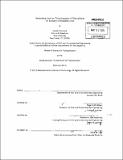Assessing Journey Time Impacts of Disruptions on London's Piccadilly Line
Author(s)
Freemark, Yonah (Yonah Slifkin)
DownloadFull printable version (24.25Mb)
Other Contributors
Massachusetts Institute of Technology. Department of Civil and Environmental Engineering.
Advisor
Nigel H.M. Wilson and Harilaos N. Koutsopoulos.
Terms of use
Metadata
Show full item recordAbstract
Public transport users depend on a reliable level of service on a daily basis. But system disruptions, caused by infrastructure problems, passenger events, and crew duty constraints, can result in reduced reliability for users. Understanding the impacts of those disruptions on customers is vital to evaluating the performance of the system and appropriately communicating delays to passengers. The goal of this thesis is to investigate the impact of certain disruptions on passenger journey times using several new metrics. The thesis has three primary components: First, a description and categorization of incidents that occur on a urban rail transport line over the course of 29 days with some degree of disruption; second, the development of a new measure of impacts on passengers resulting from those incidents using automated fare collection (AFC) data; and third, an exploration of the potential use of AFC data in real-time applications to monitor service. The proposed approach is applied to the Piccadilly Line, one of the London Underground's major rail lines. The line suffers from instances of significant disruption caused by aging technology and infrastructure, but it will not be upgraded for more than a decade. Therefore, insights from existing automated data sources, such as AFC, could play an important role in improving service without capital-intensive improvements. The passenger impact analysis method developed in the thesis relies on dividing the line into sections and aggregating all AFC transactions on all origin-destination (OD) pairs within each section. The resulting disruption impact index summarizes the effects of a disruption on the average passenger for each section of the line. In addition, the accumulation of passengers on a line is introduced as an indicator of delays relating to a disruption. These metrics are each compared with information provided by train-tracking information systems. The methods developed in the thesis were compared with actual passenger notifications on several study days. The results indicate that, despite the methods' limitations, there is potential for using AFC data, along with operational data, to provide more accurate and timely information to the users of the line. The application also leads to recommendations for how the method described for disruptions analysis could be extended to other types of analysis.
Description
Thesis (S.M. in Transportation)--Massachusetts Institute of Technology, Dept. of Civil and Environmental Engineering, 2013. Cataloged from PDF version of thesis. Includes bibliographical references (p. [165]-167).
Date issued
2013Department
Massachusetts Institute of Technology. Department of Civil and Environmental EngineeringPublisher
Massachusetts Institute of Technology
Keywords
Civil and Environmental Engineering.